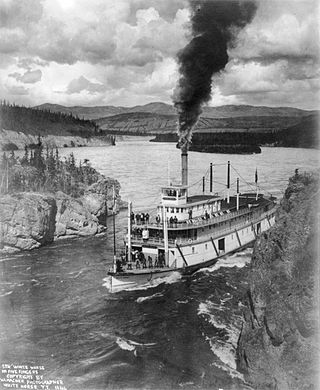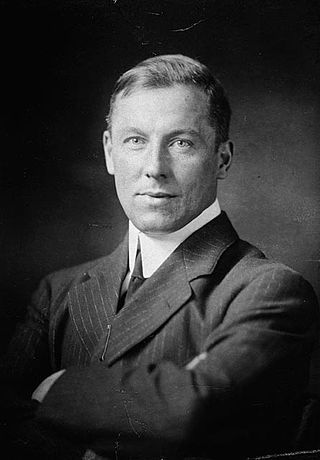Related Research Articles

Whitehorse is the capital of the Yukon, and the largest city in Northern Canada. It was incorporated in 1950 and is located at kilometre 1426 on the Alaska Highway in southern Yukon. Whitehorse's downtown and Riverdale areas occupy both shores of the Yukon River, which rises in British Columbia and meets the Bering Sea in Alaska. The city was named after the White Horse Rapids for their resemblance to the mane of a white horse, near Miles Canyon, before the river was dammed.

Yukon is the smallest and westernmost of Canada's three territories. It is the most densely populated of the three territories, with an estimated population of 46,704 as of 2024, though it has a smaller population than all provinces. Whitehorse, the territorial capital, is the largest settlement in any of the three territories.

The Municipality and Borough of Skagway is a first-class borough in Alaska on the Alaska Panhandle. As of the 2020 census, the population was 1,240, up from 968 in 2010. The population doubles in the summer tourist season in order to deal with the large number of summer tourists each year. Incorporated as a borough on June 25, 2007, it was previously a city in the Skagway-Yakutat-Angoon Census Area. The most populated community is the census-designated place of Skagway.

The Klondike Gold Rush was a migration by an estimated 100,000 prospectors to the Klondike region of Yukon in northwestern Canada, between 1896 and 1899. Gold was discovered there by local miners on August 16, 1896; when news reached Seattle and San Francisco the following year, it triggered a stampede of prospectors. Some became wealthy, but the majority went in vain. It has been immortalized in films, literature, and photographs.

Dawson City, officially the City of Dawson, is a town in the Canadian territory of Yukon. It is inseparably linked to the Klondike Gold Rush (1896–1899). Its population was 1,577 as of the 2021 census, making it the second-largest municipality in Yukon.
"The Cremation of Sam McGee" is among the most famous of Robert W. Service's poems. It was published in 1907 in Songs of a Sourdough. It concerns the cremation of a prospector who freezes to death near Lake Laberge, Yukon, Canada, as told by the man who cremates him.
Edward Hardy Harrison LL.D. was an English-Canadian artist who created many paintings of the Yukon.

Lake Laberge is a widening of the Yukon River north of Whitehorse, Yukon in Canada. It is fifty kilometres (31 mi) long and ranges from two to five kilometres wide, with an average depth of 54 metres (177 ft), a maximum depth of 146 metres (479 ft) and a surface area of 201 km2 (78 sq mi). Its water is always very cold, and its weather often harsh and suddenly variable.

Keish, also known as James Mason and by the nickname Skookum Jim Mason, was a member of the Tagish First Nation in what became the Yukon Territory of Canada. He was born near Bennett Lake, on what is now the Yukon–British Columbia border. He lived in Caribou Crossing, now Carcross, Yukon.
Thomas Robert Edward MacInnes was a Canadian poet and writer whose writings ranged from "vigorous, slangy recollections of the Yukon gold rush" to "a translation of and commentary on Lao-tzu’s philosophy". His narrative verse was highly popular in his lifetime.
"Bob Smart's Dream" is a poem written by Robert W. Service while he lived in Whitehorse, Yukon, Canada. He presented it on March 19, 1906, at a banquet held to honour J.P. Rogers, the superintendent of the White Pass and Yukon Route. The real-life Bob Smart had been the government assayer at Whitehorse since 1903.

Leroy Napoleon "Jack" McQuesten (1836–1909) was an American pioneer explorer, trader, and prospector in Alaska and Yukon; he became known as the "Father of the Yukon." Other nicknames included "Yukon Jack," "Captain Jack," "Golden Rule McQuesten," and "Father of Alaska." Together with partners Arthur Harper and Captain Alfred Mayo, he founded Fort Reliance and a wide network of trading posts in the Yukon, often providing a grubstake to prospectors. He was the most successful financially of the trio, becoming a multi-millionaire by 1898 and buying a large Victorian mansion for his family when they moved about that time to Berkeley, California.
Nationality words link to articles with information on the nation's poetry or literature.

The Northern or Northwestern is a genre in various arts that tell stories set primarily in the late 19th or early 20th century in the north of North America, primarily in western Canada but also in Alaska. It is similar to the Western genre, but many elements are different, as appropriate to its setting. It is common for the central character to be a Mountie instead of a cowboy or sheriff. Other common characters include fur trappers and traders, lumberjacks, prospectors, First Nations people, outlaws, settlers, and townsfolk.
Robert Carlin Donahue Jr., better known as "Buckwheat" Donahue, was an American folklorist, storyteller, entertainer, historian, adventurer, and four-time gold-panning champion, best known for his involvement in many different aspects of life in Alaska's Inside Passage. Although known for his time in and work with Alaska, he was born and died in Oklahoma.
"The Shooting of Dan McGrew" is a narrative poem by British-Canadian writer Robert W. Service, first published in The Songs of a Sourdough in 1907 in Canada.

Steamboats on the Yukon River played a role in the development of Alaska and Yukon. Access to the interior of Alaska and Yukon was hindered by large mountains and distance, but the wide Yukon River provided a feasible route. The first steamers on the lower Yukon River were work boats for the Collins Overland Telegraph in 1866 or 1867, with a small steamer called Wilder. The mouth of the Yukon River is far to the west at St. Michael and a journey from Seattle or San Francisco covered some 4,000 miles (6,400 km).

Robert William Service was a Scottish-Canadian poet and writer, often called “The Poet of the Yukon" and "The Canadian Kipling". Born in Lancashire of Scottish descent, he was a bank clerk by trade, but spent long periods travelling in the west in the United States and Canada, often in poverty. When his bank sent him to the Yukon, he was inspired by tales of the Klondike Gold Rush, and wrote two poems, "The Shooting of Dan McGrew" and "The Cremation of Sam McGee", which showed remarkable authenticity from an author with no experience of the gold rush or mining, and enjoyed immediate popularity. Encouraged by this, he quickly wrote more poems on the same theme, which were published as Songs of a Sourdough, and achieved a massive sale. When his next collection, Ballads of a Cheechako, proved equally successful, Service could afford to travel widely and live a leisurely life, basing himself in Paris and the French Riviera.
The Klondike Gold Rush is commemorated through film, literature, historical parks etc.
"Last Sled to Dawson" is a 1988 Scrooge McDuck comic by Don Rosa. It is Rosa's third full-length Uncle Scrooge story after The Son of the Sun and Cash Flow, both published the previous year. Last Sled is the first story in which Rosa delves into Scrooge's past life, on his journey to becoming the richest man in the world, and so acts as a spiritual sequel to Carl Barks's classic Scrooge story "Back to the Klondike", describing his experiences as a gold prospector during the Klondike Gold Rush.
References
- ↑ " Robert Service: Under the Spell of the Yukon " by Enid Mallory, YukonBooks.com, Web, April 4, 2011
- 1 2 3 4 5 "1905 R.W. Service: Bard of the Yukon", Whitehorse Star online archive, September 11, 2008.
- ↑ The Bard of the Yukon Archived 2008-10-27 at the Wayback Machine
- 1 2 3 4 Sam Holloway, "Robert Service and Destiny," The Yukoner Magazine. Web, Accessed 2008.11.19.
- 1 2 "Extended [Biography]," RobertWService.com, July 21, 2003, 2. Web, April 4, 2011
- ↑ David Evans, "Service, Robert William," Canadian Encyclopedia (Edmonton: Hurtig, 1988), 1981-1982.
- ↑ Sharon Smulders, “'A Man in a World of Men': The Rough, the Tough, and the Tender in Robert W. Service’s Songs of a Sourdough," Studies in Canadian Literature, 30:1 (2005), UNB.ca, Web, April 5, 2011.
